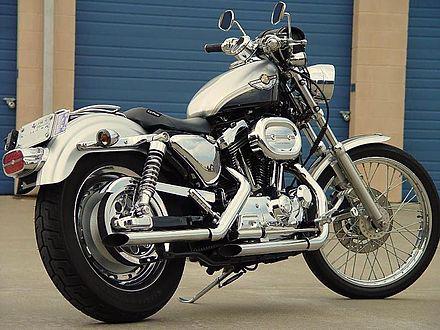Sportster Evolution
The Harley-Davidson Sportster has been a core part of motorcycle culture since its introduction in 1957. Originally designed for dirt track racing, the early Sportster used the K-series engine, which provided improved agility and reliability compared to previous models.
Over the decades, the Sportster has evolved with technological advancements while maintaining its distinctive character. The introduction of the Evolution engine in 1986 marked a significant step forward in terms of power, efficiency, and reliability. This engine addressed many of the issues associated with earlier models, such as oil leaks and high maintenance requirements.
The Sportster has also become a popular platform for customization, allowing riders to express their personal style. Models like the Iron 883, introduced in the late 2000s, appealed to riders who desired a minimalist, stripped-down aesthetic.
Technological improvements have further enhanced the Sportster's performance and rider experience. The transition to electronic fuel injection improved throttle response and power delivery, while the introduction of rubber-mounted engines in 2004 reduced vibrations and increased comfort for longer rides.
The latest iteration, the Sportster S, features the Revolution Max engine, which offers increased power and advanced rider aids like selectable ride modes and traction control. The Sportster's frame has also evolved, with newer models incorporating lightweight alloy construction.
Throughout its history, the Sportster has remained true to Harley-Davidson's commitment to blending tradition with innovation, offering riders a machine that combines classic style with modern performance.
Comparative Analysis of Engine Performance
Harley-Davidson's engine lineup showcases the brand's ability to cater to different riding styles and preferences. The Pan America, Sportster S, and Fat Bob 114 each offer distinct performance characteristics that define their purpose and character.
The Pan America's Revolution Max 1250 engine is designed for adventure touring, delivering 150 horsepower and 94 lb-ft of torque. Its variable valve timing ensures optimal performance across a wide range of RPMs, making it suitable for both highway cruising and off-road excursions.
The Sportster S, powered by the Revolution Max 1250T engine, emphasizes low-end torque, producing 121 horsepower and 94 lb-ft of torque. This tuning enhances responsiveness and makes the Sportster S well-suited for urban riding and quick acceleration.
The Fat Bob 114 features the classic Milwaukee-Eight engine, which delivers 100.5 horsepower and 118 lb-ft of torque. This engine's focus on straight-line performance and the iconic Harley-Davidson V-Twin rumble appeals to riders who value a more traditional power cruiser experience.
These engines demonstrate Harley-Davidson's ability to tailor performance to specific riding styles and preferences. Whether it's the versatility of the Pan America, the urban agility of the Sportster S, or the classic power of the Fat Bob 114, each engine offers a unique riding experience that caters to different rider demands.
Impact of Design on Rider Experience
The design elements of a motorcycle play a crucial role in shaping the overall riding experience. Models like the Road King and Dyna Wide Glide exemplify how different design choices can cater to specific riding preferences.
The Road King, known for its touring capabilities, features a sturdy chassis and a combination of emulsion-technology rear shock and telescopic front fork. This setup provides stability at higher speeds and smooths out rough road surfaces, making it ideal for long-distance rides. The plush and supportive seating further enhances comfort during extended hours in the saddle.
On the other hand, the Dyna Wide Glide prioritizes agility and a street-oriented riding style. Its raked front end and longer fork enable sharper turns and nimble handling in tight corners and sweeping bends. However, this design compromises some of the smooth handling found in touring models. The lower seating position of the Wide Glide promotes a laid-back riding posture, which is comfortable for short city rides but may not offer the same level of long-distance comfort as a dedicated touring model.
Both the Road King and Dyna Wide Glide showcase Harley-Davidson's commitment to combining robust build quality with distinctive styling. The Road King's frame and suspension are designed to handle the demands of diverse terrains, while the Dyna Wide Glide's responsive frame and suspension prioritize maneuverability and exhilarating ride dynamics.
These examples highlight how motorcycle design directly influences the rider experience. The choice between models like the Road King and Dyna Wide Glide ultimately depends on the rider's personal preferences and intended use. Harley-Davidson's diverse lineup ensures that riders can find a motorcycle that aligns with their specific needs and riding style.
Market Reception and Popularity Trends
Harley-Davidson's motorcycle lineup has experienced varying market reception, with a notable contrast between traditional models and innovative offerings. The Electra Glide, a classic touring model, has maintained a strong and steady presence in the market. Its enduring popularity is attributed to consistent updates that enhance performance and comfort while preserving its iconic design. The Electra Glide's reputation often leads to sales through word-of-mouth recommendations and a loyal customer base.
In contrast, Harley-Davidson's venture into the electric motorcycle market with the LiveWire has been met with mixed reactions. While the LiveWire offers impressive performance, such as instant torque and a range of 146 miles in the city, its high price point and limited charging infrastructure have been barriers for some traditional Harley-Davidson customers. However, as environmental awareness grows, there is an increasing interest in sustainable transportation options, and the LiveWire is starting to gain traction among a niche market of tech-savvy riders.
Harley-Davidson has faced criticism regarding its strategic decisions surrounding production and market targeting for electric models. Some analysts and enthusiasts suggest that expanding accessibility and more targeted marketing could broaden the appeal of electric offerings. The company has acknowledged this feedback and continues to make advancements in areas such as battery life and connectivity features.
The market performance of the LiveWire and Electra Glide reflects a generational divide among motorcycle consumers. Younger, environmentally conscious riders show interest in innovative models, while older demographics remain loyal to the classic styling and gas-powered engines of traditional Harley-Davidson motorcycles.
As Harley-Davidson navigates this landscape, balancing tradition with innovation, the market's response continues to evolve. By ensuring that cutting-edge models maintain the brand's signature performance and styling, Harley-Davidson aims to attract younger, tech-savvy customers while still appealing to its core audience. The integration of modern features and advancements into classic models will likely shape the future of Harley-Davidson's lineup and its market reception.
The Harley-Davidson Sportster's evolution showcases the brand's ability to blend technological advancements with its rich heritage. Each model in the Sportster lineup reflects a commitment to enhancing the riding experience while preserving the essence that has made the Sportster an icon in motorcycle culture.
- The Sportster's evolution has been marked by significant milestones, such as the introduction of the Evolution engine in 1986, which improved power, efficiency, and reliability.
- Models like the Iron 883 have appealed to riders seeking a minimalist, stripped-down aesthetic, while the Sportster S incorporates advanced features like selectable ride modes and traction control.
- The Sportster's versatility as a platform for customization has allowed riders to express their personal style and create unique machines that reflect their individuality.
As Harley-Davidson continues to evolve the Sportster lineup, it remains committed to honoring its legacy while embracing modern technology and design. The Sportster's enduring popularity is a testament to its ability to captivate riders across generations, offering a timeless riding experience that combines classic style with contemporary performance.
- Harley-Davidson Motor Company. Sportster Models. Harley-Davidson USA. https://www.harley-davidson.com/us/en/motorcycles/sportster.html.
- Harley-Davidson Motor Company. Harley-Davidson Engines. Harley-Davidson USA. https://www.harley-davidson.com/us/en/motorcycles/engines.html.
- Harley-Davidson Motor Company. Touring Motorcycles. Harley-Davidson USA. https://www.harley-davidson.com/us/en/motorcycles/touring.html.
- Harley-Davidson Motor Company. LiveWire Electric Motorcycle. Harley-Davidson USA. https://www.harley-davidson.com/us/en/motorcycles/livewire.html.















